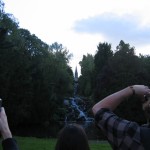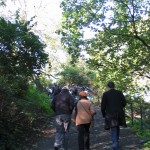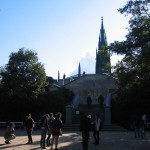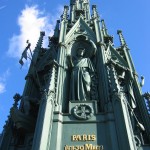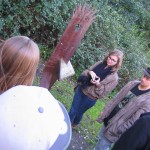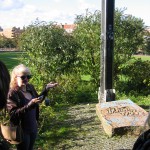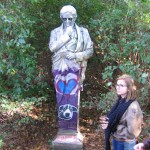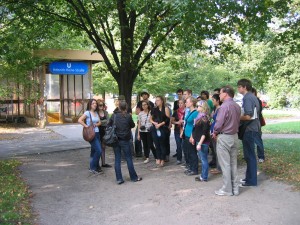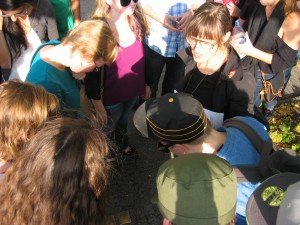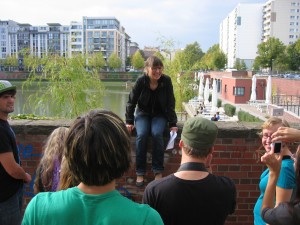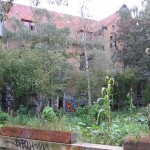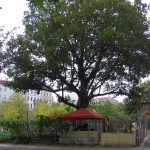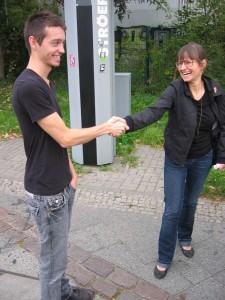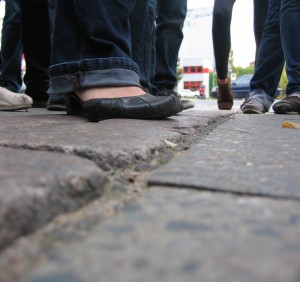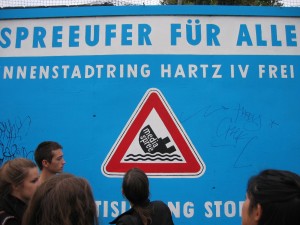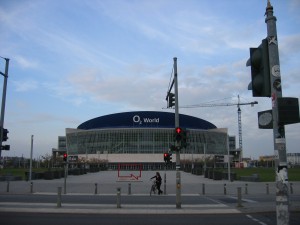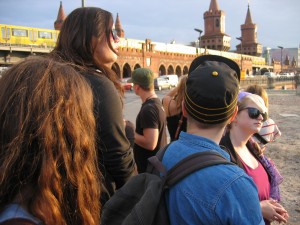Viktoriapark walk with Annie, Melissa and Rachel
Our students Annie, Melissa and Rachel took us on a tour of Viktoriapark this week. As they explained, the park is home to the “Kreuzberg” (literally “Cross Mountain”) and gives its name to the surrounding neighborhood. The “Kreuz” – really a monument to the wars of liberation against Napoleon – was designed by this week’s featured 19th-century starchitect, Karl Friedrich Schinkel.
It’s a bit of a climb …
… but it’s worth it! There are beautiful views of the city, and of course, a lovely gothic monument to admire as well.
Schinkel isn’t the only artist to have left his mark (whether officially sanctioned or not) on the park. Our guides showed us an artwork commemorating a recent act of sexual violence in the park, another in honor of the uprising of Communist workers in 1953, and one (a spray-paint-covered statue of Heinrich von Kleist) that attests to one of Berlin’s biggest vandalism issues – graffiti. As in the rest of Berlin, Viktoriapark is packed with history, and our tour guides did a lovely job of uncovering some of that for us.
A walk through our Kiez with Manuela Mangold
Manuela Mangold, a long-time Kreuzberger, gave us a fantastic tour of the students’ “Kiez” in Berlin on Tuesday afternoon. Kiez is a local word meaning “neighborhood,” but it denotes not just a district of the city (in this case, Kreuzberg), but one’s immediate, local surroundings — the place where everyday life is lived.
We started our tour at the Heinrich-Heine-Strasse U-Bahn station, the stop where the students regularly get onto the subway. During the time when Berlin was divided, it was a border crossing used mainly for commercial traffic. Below, the subway station was a “ghost station” — because the wall ran in a zig-zag manner from roughly the southeast to the northwest, trains going from this part of West Berlin would pass under East Berlin on their way to other parts of West Berlin would pass through a completely darkened (and sometimes guarded) station.
Next on our tour was an example of Stolpersteine (“Stumble Stones”), an art project begun in Cologne, but which has left its mark all over Berlin. A form of Holocaust memorial, it marks where victims of the tragedy once lived. People are meant to “stumble” over these on their daily walks, a constant reminder of the importance of remembering the Holocaust, and its impact on life here.
We continued with a look at the path of the Berlin Wall and death strip. Manuela is sitting right between former East and West in the picture! As in most of Berlin, it’s been restored so nicely now that barely a trace of the division remains.
Oppositional culture has been a huge part of Kreuzberg’s identity since the 1970s. Here are two examples of “squatter” culture — both built right up against the Wall. One is a famous house squat, and the other a garden built right in the shadow of the wall, in what was technically East German territory!
We continued along the path of the wall, which is (in some places) marked by a strip of brick set into the ground. (Dominic represented East Germany, shaking hands with a West Berliner!)
Leaving our Kiez and crossing the Spree River, we continued on to talk about the politics of development along the river banks, another area where squatters and other oppositional movements have traditionally made their homes. Now big developers are buying up large swaths of property, driving up rents and bringing a whole new feel to the neighborhood, garnering vehement protest from locals. One glaring example of this is O2 World, a large concert venue whose undeniably corporate aura conflicts tangibly with its surroundings. Its VIP entrance along the river was heavily protested, but got built anyway.
We ended our tour at the Oberbaumbrücke, which was also divided by the Wall. Now, as you can see in the background, the U1 train line can run all the way across it again!
Our Kiez is in some ways the perfect spot for the students, sitting uncomfortably amidst the former East and West, scarred with layers of memory and history – and still transforming before our eyes.
tags
the author
I'm a doctoral student at CUNY Graduate Center. I'm thrilled to be teaching the CHID Berlin program with Prof. John Toews! You can contact me at naraelle [at] gmail.com, or find out more about me at www.naraelle.net.
Blogroll
- Annie Holden's blog
- Cassie Hoeprich's blog
- Dominic Barrera's blog
- Janet Williams's blog
- Mariah Alderete's blog
- Melissa Au's blog
- Robert Hampton's blog
- UW Students Study Abroad Our students Natalie and Cassie are contributing to the official IPE student blog this fall!



